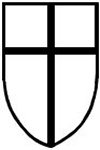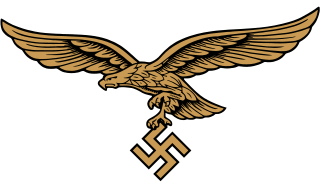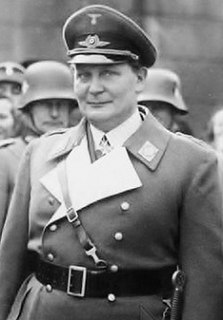Fallschirmjäger is the German word for paratroopers. They played an important role during World War II, when, together with the Gebirgsjäger they were perceived as the elite infantry units of the German military. After World War II, they were reconstituted as parts of postwar armed forces of both West and East Germany, mainly as special ops troops.

Volksgrenadier was the name given to a type of German Army division formed in the Autumn of 1944 after the double loss of Army Group Center to the Soviets in Operation Bagration and the Fifth Panzer Army to the Allies in Normandy. The name itself was intended to build morale, appealing at once to nationalism (Volk) and Germany's older military traditions (Grenadier). Germany formed 78 VGDs during the war. Volksgrenadier divisions were professional military formations with effective weapons and equipment, unlike the unrelated Volkssturm militia.

Panzergrenadier, shortened as PzGren (modern) or PzG (WWII), is a German term for motorised or mechanized infantry – that is, infantry transported in combat vehicles specialized for such tasks – as introduced during World War II. It is used in the armies of Austria, Germany and Switzerland.
A panzer division is one of the armored (tank) divisions in the Wehrmacht of Nazi Germany during World War II. This is a more restricted meaning than the German-language equivalent Panzerdivision, still used in the modern German Army of the Bundeswehr. In German-speaking countries, Panzerdivision is not immediately associated with the Wehrmacht as it is in English, as the German term simply means "armored division" and has no additional connotation.
The Fallschirm-Panzer-Division 1. Hermann Göring was an elite German Luftwaffe armoured division. The HG saw action in North Africa, Sicily, Italy and on the Eastern Front. The division began as a battalion-sized police unit in 1933. Over time it grew into a regiment, brigade, division, and finally was combined with the Parachute-Panzer Division 2 Hermann Göring on May 1, 1944 to form a Panzer corps under the by then Reichsmarschall. It surrendered to the Soviet Army near Dresden on May 8, 1945.

The 716th Static Infantry Division was a World War II, German Army infantry division. It was raised on May 2, 1941, and sent to German-occupied France in June 1941. Many of the division's troops were elderly Germans and conscripts from other German occupied countries, especially Ukrainians. As a bodenständig it was not equipped with the standard configuration of vehicles and heavy weapons. Much of the division's artillery and anti-tank guns were from captured armaments.

The 91st Air Landing Division was a German Army infantry division in World War II.

The 78th Infantry Division, later the 78th Sturm (Assault) Division, was a German infantry formation which fought during World War II.

The 12th Infantry Division – later known as the 12th Volksgrenadier Division – was a Wehrmacht military unit of Nazi Germany that fought during World War II. The division was formed in 1934. It participated in the invasion of Poland in 1939 and the 1940 campaign in France and the Low Countries. In the Soviet Union, the division joined Operation Barbarossa. The division was destroyed in the Soviet Operation Bagration in the summer of 1944. The division was re-activated in September 1944 and posted to the newly created Western Front.

The 61st Infantry Division was a combat division of the German Wehrmacht during the Second World War.

Between 1933 and 1945, the organization of the Luftwaffe underwent several changes. Originally, the German military high command, for their air warfare forces, decided to use an organizational structure similar to the army and navy, treating the aviation branch as a strategic weapon of war. Later on, during the period of rapid rearmament, the Luftwaffe was organized more in a geographical fashion.

The 183rd Volksgrenadier Division was a German unit during World War II.

The 26th Infantry Division was a pre-World War II German Infantry Division of the 1st mobilisation wave. It was mobilised for World War II on September 26, 1939, disbanded on September 10, 1944, near Radom and reformed as the 26th Volksgrenadier Division on September 17, 1944, near Poznań by absorption of the new 582nd Volksgrenadier Division of the 32nd mobilisation wave. Remnants of the Division entered U.S. captivity in the Harz region in 1945.

The 272nd Infantry Division was a Type 1944 infantry division of the German Wehrmacht during World War II, that was originally formed in December 1943. The division fought in many of the major battles throughout Operation Overlord, culminating in the Retreat from Northern France and the Low Countries in late August/early September 1944.

The 272nd Volksgrenadier Division, was a German Army volksgrenadier division formed following the defeats of the Normandy Campaign in 1944. Composed of men taken from existing Heer units and airmen and sailors retasked to infantry duties, the division fought on the retreating Western Front until it was largely encircled in the Ruhr Pocket in April 1945.

The Fallschirmjäger were the paratrooper branch of the German Luftwaffe before and during World War II. They were the first German paratroopers to be committed in large-scale airborne operations and came to be known as the "green devils" by the Allied forces they fought against. The Fallschirmjäger were very effective when used in commando style raids. The Fallschirmjäger were famous for their willingness to give every effort unwaveringly even in the grimmest of situations. The Fallschirmjäger were seldom used as parachutists. Instead, they were prized for their combat abilities and frequently acted in a "fire brigade" role as roving elite infantrymen. Throughout World War II the Fallschirmjäger commander was Kurt Student.
The 14th Luftwaffe Field Division(14. Luftwaffen-Felddivision) was a Luftwaffe infantry division of the Wehrmacht during World War II. It was transferred to the German Army in November 1943 as the 14th Field Division (L) and spent its entire operational existence on occupation duties in Norway and Denmark. It saw no ground combat during its period of service.























